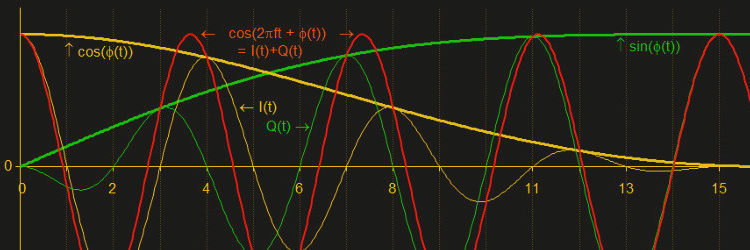If The I And Q Of Software Defined Radio Are Your Nemesis, Read On
For those of us whose interests lie in radio, encountering our first software defined radio must have universally seemed like a miracle. Here is a surprisingly simple device, essentially a clever mixer and a set of analogue-to-digital or digital-to-analogue converters, that can import all the complex and tricky-to-set-up parts of a traditional radio to a computer, in which all signal procession can be done using software.
When your curiosity gets the better of you and you start to peer into the workings of a software defined radio though, you encounter something you won’t have seen before in a traditional radio. There are two mixers fed by a two local oscillators on the same frequency but with a 90 degree phase shift, and in a receiver the resulting mixer products are fed into two separate ADCs. You encounter the letters I and Q in relation to these two signal paths, and wonder what on earth all that means.
What you have just seen is a quadrature mixer. Quadrature refers to anything mathematical that involves a quarter circle, in this case the 90 degree phase shift between the two local oscillators. This 90 degree phase shift has the property of revealing not only the frequency and amplitude information in the signal that you would be familiar with from a single mixer in a traditional radio, but also the phase information within it that the two 90 degree out of phase I (In phase) and Q (Quadrature) component signals preserve.
There is a significant amount of maths to be digested if you wish to fully get to the bottom of how this works, for which it is probably best to direct the curious to a more lengthy explanation. For a quick understanding though it is best to imagine the sine wave amplitude view of a signal that you might see on an oscilloscope as merely a 2D side view of a signal that is in fact a 3D spiral because it also has a phase component. If this side view of a spiral were your I component then a similar 2D view of the top of the spiral would be your Q component, the same signal but with a 90 degree phase difference. From these two I and Q signals can be reconstructed the whole of the original signal including its complex phase relationships, rather than simply the 2D amplitude view that you might see on an oscilloscope.
Happily this isn’t one of those things that exists only as a piece of theory in a text book, you can easily build a simple SDR receiver front end based on the quadrature mixer diagram above on your bench. If you are prepared to restrict the receiver’s bandwidth to that of your computer’s audio card, often in the 50 kHz range, you can use the left and right audio inputs as your I and Q respectively, and run one of the many SDR applications. Linrad is just one example.
As to the hardware, the mixers and associated low pass filter can be extremely straightforward to build, for example you could try lifting this design using a CMOS analogue switch. And though you might imagine that creating the 90 degree phase shift would present a problem, in fact that too can be easily performed with a pair of flip-flops. Add in a logic level oscillator and it’s then possible to make a software defined radio front end almost entirely from logic chips, save for a couple of op-amps. It won’t perform much beyond the HF (shortwave) frequencies, but even if you only use it to look at your local AM broadcast stations it can still give you a hands-on understanding of SDR hardware.
It sometimes seems as though SDRs are magical black boxes surrounded in a cloud of marketing woo. And with the exception of the famous RTL chipset USB TV receivers they seem to attract a price to match the hype. But the reality is that from the hardware perspective they can be surprisingly simple. Why not break out a breadboard and hack yourself together a simple one!
Header image: Bob K [CC0].


Comments are closed.